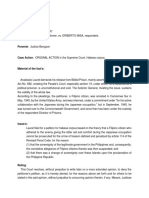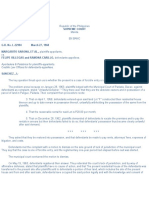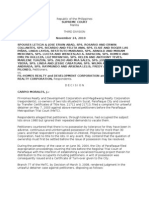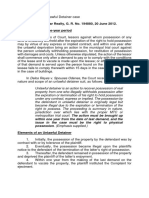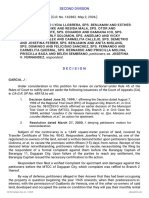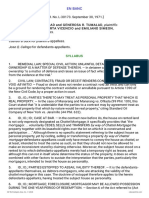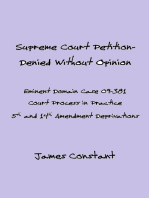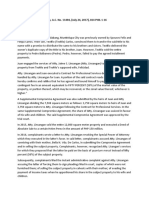SARONA vs. VILLEGAS
SARONA vs. VILLEGAS
Uploaded by
Jerikka AcuñaCopyright:
Available Formats
SARONA vs. VILLEGAS
SARONA vs. VILLEGAS
Uploaded by
Jerikka AcuñaCopyright
Available Formats
Share this document
Did you find this document useful?
Is this content inappropriate?
Copyright:
Available Formats
SARONA vs. VILLEGAS
SARONA vs. VILLEGAS
Uploaded by
Jerikka AcuñaCopyright:
Available Formats
VOL.
22, MARCH 27, 1968 1257
Sarona vs. Villega
No. L-22984. March 27, 1968.
MARGARITO SARONA, ET AL., plaintiffs-appellants, vs.
FELIPE VILLEGAS and RAMONA CARILLO, defendants-
appellees.
Forcible entry and detainer; Forcible entry distinguished from
unlawful detainer; Nature of entry determines cause of
1258
1258 SUPREME COURT REPORTS ANNOTATED
Sarona vs. Villegas
action.—Section 1, Rule 70 of the Revised Rules of Court defines
two entirely distinct causes of action, to wit: (a) action to recover
possession founded on illegal occupation from the beginning—
forcible entry; and (b) action founded on unlawful detention by a
person who originally acquired possession lawfully—unlawful
detainer. The law and jurisprudence leave no doubt that what
determines the cause of action is the nature of defendant's entry
into the land. .If entry is illegal, then the cause of action which
may be filed against the intruder within one year therefrom is
forcible entry. If, on the other hand, entry is legal but thereafter
possession became illegal, the case is one of illegal detainer which
must be filed within one year from the date of last demand.
Same; Pleadings and practice; Failure of the complaint to aver
jurisdictional facts; Effect.—The jurisdictional facts must appear
on the 'face of the complaint. Where, as here, the only definite
ultimate facts averred are that on April 1, 1958, defendants
entered upon the land and construed their residential house
thereon, remained in possession thereof, and that demand to
vacate and pay rentals only was made on December 28, 1962, so
that it is not clear whether said action filed on January 28, 1963
with the Municipal Court of Padada, Davao, was one of illegal
detainer or forcible entry, then the municipal court of Padada did
not have jurisdiction. The municipal court should have dismissed
the case especially after it came to light, when the parties went to
trial on the merits, that defendants' entry was illegal at the
inception. Clearly, plaintiffs' case fits in the jurisprudential
precept of forcible entry and should have been filed within one
year from such entry.
Unlawful detainer; Tolerance must be from the start of
possession sought to be recovered.—A close assessment of the law
and the concept of the word "tolerance" show that such tolerance
must be present right from the start of possession sought to be
recovered, to categorize a cause of action as one of unlawful
detainer—not of forcible entry.
Forcible entry and unlawful detainer; Failure to bring action
within one year; Remedy.—It is well to remember that after the
lapse of the one year period, suit must be started in the Court of
First Instance in an accion publiciana.
APPEAL from an order of dismissal of the Court of First
Instance of Davao.
The facts are stated in the opinion of the Court.
Aportadera & Palabrica for plaintiffs-appellants.
Castillo Law Offices for defendants-appellees.
1259
VOL. 22, MARCH 27, 1968 1259
Sarona vs. Villegas
SANCHEZ, J.:
The key question thrust upon us is whether the present is a
case of forcible entry or one of unlawful detainer. The
problem arose because on January 28, 1963, plaintiffs
lodged with the Municipal Court of Padada, Davao, against
1
defendants a complaint styled "Unlawful Detainer." They
there aver that they are the absolute owners and in
possession of a parcel of land in Paligue, Padada. Their
complaint then proceeds to recite:
"3. That on April 1, 1958, defendants entered upon said land
Lot 'F' constructed their residential house thereon and up
to date remain in possession thereof, unlawfully
withholding the possession of the same from the plaintiffs;
4. That the reasonable rental for said Lot is P20.00 per
month;
5. That on December 28, 1962, plaintiffs demanded of
defendants to vacate the premises and to pay the rentals
in arrears but then defendants failed to do so; that
defendants' possession thus became clearly unlawful after
said demand;
x x x."
They asked that they be restored into possession, and that
defendants be made to pay rents, attorneys' fees, expenses
of litigation, and costs.
Defendants met the complaint with a motion to dismiss
on the sole ground of lack of jurisdiction of the municipal
court. They say that the case is one of forcible entry, and
the reglementary one-year period had elapsed before suit
was started.
The municipal court overturned the motion to dismiss.
On May 15, 1963, defendants registered their answer.
They reiterated the court's lack of jurisdiction, and by way
of affirmative defenses, stated that plaintiffs have no cause
of action, and that "the present residential house of the
defendants was transferred to the present site after
plaintiffs sold to defendants a portion of their land, which
includes the site of the present house and from and after
_______________
1 Civil Case 164, Municipal Court of Padada, Davao entitled "Margarito
Sarona, Antero Sarona, Ireneo Sarona, Lucila Sarona, Francisco Sarona,
Felisa Sarona, and Montana Sarona, Plaintiffs, vs. Felipe Villegas and
Ramona Carillo, Defendants."
1260
1260 SUPREME COURT REPORTS ANNOTATED
Sarona vs. Villegas
said sale, defendants have occupied the said portion legally
and with the knowledge and consent of plaintiffs." They
counterclaimed for damages.
The municipal court's judgment directed defendants to
vacate the premises, to pay plaintiffs a monthly rental of
P10.00 from April 1, 1958 until possession is restored, and
P200.00 as attorneys' fees, and costs.
Defendants,
2
on appeal to the Court of First Instance of
Davao, renewed their bid to throw out of court plaintiffs'
complaint for want of jurisdiction. Plaintiffs' opposition and
defendants' reply thereto were also submitted. On
December 26, 1963, the Court of First Instance of
Davao dismissed the case. The court reasoned out that
the suit was one of forcible entry and was started beyond
the reglementary one-year period.
Plaintiffs appealed to this Court.
Plaintiffs' position is that the municipal court had
original jurisdiction; that consequently the Court of First
Instance had appellate jurisdiction. Their theory is that
suit was well within the one-year period. They say that the
parting date is December 28, 1962, when plaintiffs
demanded of defendants to vacate the premises and pay
rentals in arrears; and that the complaint was registered in
court on January 28, 1963.
Solution of the problem turns on this question: Is the
complaint one of forcible entry or unlawful detainer?
1. Section 1, Rule 70 (formerly Section 10, Rule 72) of
the Revised Rules of Court, states that a person deprived of
possession of land "by force, intimidation, threat, strategy,
or stealth," or a person against whom the possession of any
land "is unlawfully withheld after the expiration or
termination of the right to hold possession, by virtue of any
contract, express or implied," may at any time "within one
(1) year after such unlawful deprivation or withholding of
possession, bring an action in the proper inferior court
against the person or persons unlaw-
_______________
2 Civil Case 4184, Court of First Instance of Davao—Sarona, et al.,
plaintiffs, versus Villegas, et al., defendants.
1261
VOL. 22, MARCH 27, 1968 1261
Sarona vs. Villegas
fully withholding or depriving of possession." The next
legal precept, Section 2 of the same Rule, provides that the
landlord may not sue his tenant for ejectment "for failure to
pay rent due or to comply with the conditions of his lease,
unless the tenant shall have failed to pay such rent or
comply with such conditions for a period of fifteen (15)
days, or five (5) days in the case of building, after demand
therefor, x x x."
It is plain that the foregoing rules define two entirely
distinct causes of action, to wit: (a) action to recover
possession founded on illegal occupation from the
beginning—forcible entry; and (b) action founded on
unlawful detention by a person who 3originally acquired
possession lawfully—unlawful detainer.
The law and jurisprudence leave no doubt in our mind
that what determines the cause of action is the nature of
defendants' entry into the land. If entry is illegal, then the
cause of action which may be filed against the intruder
within one year therefrom is forcible entry. If, on the other
hand, entry is legal but thereafter possession became
illegal, the case is one of illegal detainer which must be
filed within one year from the date of the last demand.
2. We observe a lack of precision-tooling in the
complaint. Defendants' alleged entry into the land is not
characterized—whether legal or illegal. It does not say how
defendants entered the land and constructed their
residential house thereon. It is silent, too, whether
possession became legal before plaintiffs made the demand
to vacate and to pay rentals.
Nor does the complaint as much as intimate that
defendants are plaintiffs' tenants. So that the case would
not come within the coverage of Section 2 of Rule 70
(summary action by landlord against tenant).
Failure to specifically aver in the complaint facts which
definitely show that plaintiffs' action is for forcible entry or
unlawful detainer, is not to be lightly treated. Juris-
_______________
3 Medel vs. Militante, 41 Phil. 526, 530; Dy Sun vs. Brillantes, 93 Phil.
175, 177.
1262
1262 SUPREME COURT REPORTS ANNOTATED
Sarona vs. Villegas
diction here—challenged in a motion to dismiss—depends
upon factual averments. The jurisdictional facts must
appear on the face of the complaint. Where, as here, the
only definite ultimate facts averred are that on April 1,
1958, defendants entered upon the land and constructed
their residential house thereon, remained in possession
thereof, and that demand to vacate and pay rentals only
was made on December 28, 1962, well beyond the oneyear
period, the municipal court of Padada did not have
jurisdiction.
The want of jurisdiction is the more accentuated when
we consider the facts that surfaced during the trial as
found by the municipal court, viz:
"ln the course of the hearing of this case it is clear that, according
to the plaintiff, Margarito Sarona, the defendants transferred
their house on April 1, 1958 to the litigated area which is
designated as Lot F, (Exhibit 'C-1') without their consent and
permission. At that time he was just living 200 meters away from
the lot. He requested the defendants not to place the said house in
the litigated area but the defendants refused. He did nothing and
only on December 28, 1962, when the formal letter of demand to
vacate and to pay rental was made by the plaintiff through their
lawyer, Atty. Palabrica, and addressed the said letter to the
defendants but the defendants refused to vacate the area and to
pay a rental of P20.00. x x x."
It is then too plain for argument that defendants entered
the land on April 1, 1958 without plaintiffs' consent and
permission; that plaintiff Margarito Sarona "requested the
defendants not to place the said house in the litigated area
but the defendants refused."
The findings of the municipal court itself may not be
downgraded in the present case. And this, for the reason
that the complaint did not specifically state the manner of
entry of defendants into the land—legal or illegal. Since the
parties went to trial on the merits, and it came to light that
defendants' entry was illegal at the inception, the
municipal court should have dismissed the case. That court
cannot close its eyes to the truth revealed by plaintiffs' own
evidence before it. A court of limited juris-
1263
VOL. 22, MARCH 27, 1968 1263
Sarona vs. Villegas
diction, said municipal court, should not have
4
proceeded to
render an on-the-merits judgment thereon.
Clearly, plaintiffs' case fits in the jurisprudential
precept of forcible entry. Because the entry is forcible. Long
had it been made evident that in forcible entry cases, no
force is really necessary—
"In order to constitute the use of force,' as contemplated in this
provision, the trespasser does not have to institute a state of war.
Nor is it even necessary that he should use violence against the
person of the party in possession. The act of going on the property
and excluding the lawful possessor therefrom necessarily implies
the exertion of force over the property, and this is all that is
necessary. Under the statute entering upon the premises by
strategy or stealth is equally as obnoxious as entering by force.
The foundation of the action is really the forcible exclusion of the
original possessor by a person who has entered without right. The
words 'by force, intimidation, threat, strategy .or stealth' include
every situation or condition under which one person can
wrongfully enter upon real property and exclude another, who has
had prior possession, therefrom. If a trespasser enters upon land
in open daylight, under the very eyes of the person already
clothed with lawful possession, but without the consent of the
latter, and there plants himself and excludes such prior possessor
from the property, the action of forcible entry and detainer can
unquestionably be maintained, even though no force is used by
the trespasser other than such as is necessarily implied from the
mere acts of5 planting himself on the ground and excluding the
other party."
3. But plaintiffs would want to make out a case of illegal
detainer upon their belated claim that they tolerated
defendants' possession. To be observed on this point is that
there has been no allegation in the complaint, and no
showing during the trial in the municipal court, that
possession of defendants ever changed from illegal to legal
any time from their illegal entry to the demand to vacate.
No averment there is in the complaint which recites—as a
fact—any overt act on plaintiffs' part indicative of
permission to occupy the land. Without resorting to
_______________
4 Cf. Iñi&o vs. Estate of Adriana Maloto, L-24384, September 28, 1967,
citing cases.
5 Mediran vs. Villanueva, 37 Phil. 752, 756-757, quoted with approval
in Santos vs. Santiago, 38 Phil. 575, 577-578.
1264
1264 SUPREME COURT REPORTS ANNOTATED
Sarona vs. Villegas
mind-reading, we are hard put to conclude that there was
such a change from illegal to legal possession of def
endants until the demand to vacate was made.
But even where possession preceding the suit is by
tolerance of the owner, still, distinction should be made.
If right at the incipiency defendants' possession was
with plaintiffs' tolerance, we do not doubt that the latter
may require him to vacate the premises and sue before the
inferior court under Section 1 of Rule 70, within one year
from the date of the demand to vacate, Because, from the
date of demand, possession
6
became unlawful. And the case
is illegal detainer.
But will this rule as to tolerance hold true in a case
where there was forcible entry at the start, but the lawf ul
possessor did not attempt to oust the intruder for over one
year, and only thereafter filed forcible entry suit following
demand to vacate?
Professor Arturo M. Tolentino states that acts merely
tolerated are "those which by reason of neighborliness or
familiarity, the owner of property allows his neighbor or
another person to do on the property; they are generally
those particular services or benefits which one's property
can give to another without material injury or prejudice to
the owner, 7
who permits them out of f riendship or
courtesy." He adds that: "[t]hey are acts of little
disturbances which a person, in the interest of
neighborliness or friendly relations, permits others to do on
his property, such as passing over the land, tying a horse
therein, or getting some water from a well." And, Tolentino
continues, even though "this is continued for a 8long time,
no right will be acquired by prescription." Further
expounding on the concept, Tolentino writes: "There is tacit
consent of the possessor to the acts which are merely
tolerated. Thus, not every case of knowledge and silence
_______________
6 3 Moran, Comments on the Rules of Court, 1963 ed., p. 287, citing
Minute Resolution in Amis vs. Aragon. L-4735-47364684, April 28, 1951.
7 II Tolentino, Civil Code of the Philippines, 1963 ed., p. 227, citing I
Ruggiero 843; Italics supplied.
8 Id., citing 2-11 Colin & Capitant 911; italics supplied.
1265
VOL. 22, MARCH 27, 1968 1265
Sarona vs. Villegas
on the part of the possessor can be considered mere
tolerance. By virtue of tolerance that is considered as an
authorization, permission or license, acts of possession are
realized or performed. The question reduces9 itself to the
existence or non-existence of the permission."
A close assessment of the law and the concept of the
word "tolerance" confirms our view heretofore expressed
that such tolerance must be present right from the start of
possession sought to be recovered, to categorize a cause of
action as one of unlawful detainer—not of forcible entry.
Indeed, to hold otherwise would espouse a dangerous
doctrine. And for two reasons: First. Forcible entry into the
land is an open challenge to the right of the possessor.
Violation of that right authorizes the speedy redress—in
the inferior court—provided for in the rules. If one year
from the forcible entry is allowed to lapse before suit is
filed, then the remedy ceases to be speedy; and the
possessor is deemed to have waived his right to seek relief
in the inferior court. Second. If a forcible entry action in the
inferior court is allowed after the lapse of a number of
years, then the result may well be that no action of forcible
entry can really prescribe. No matter how long such
defendant is in physical possession, plaintiff will merely
make a demand, bring suit in the inferior court—upon a
plea of tolerance to prevent prescription to set in—and
summarily throw him out of the land. Such a conclusion is
unreasonable. Especially if we bear in mind the postulates
that proceedings of forcible entry and unlawful detainer are
summary in nature, and that the one year time-bar to the
suit is10 but in pursuance of the summary nature of the
action.
It is well to remember that after the lapse of the one
year period, suit must be started in the Court of First
Instance in an accion publiciana.
Jurisdiction in the case before us is with the Court of
First Instance.
_______________
9 Ibid; italics supplied.
10 Monteblanco vs. Hinigaran Sugar Plantation, 63 Phil 797, 802-803
1266
1266 SUPREME COURT REPORTS ANNOTATED
Amalgamated Laborers' Assn. vs. Court of Industrial
Relations
For the reasons given, the order of the Court of First
Instance of Davao of December 26, 1963 dismissing the
case for want of jurisdiction in the Municipal Court of
Padada, is hereby affirmed.
Costs against plaintiffs-appellants. So ordered.
Reyes, J.B.L., Actg. C.J., Dizon, Makalintal,
Bengzon, J.P., Zaldivar, Angeles and Fernando, JJ.,
concur.
Castro, J., did not take part.
Concepcion, C.J., is on leave.
Order affirmed.
———————————
© Copyright 2020 Central Book Supply, Inc. All rights reserved.
You might also like
- Sample MTC Decision Unlawful DetainerDocument3 pagesSample MTC Decision Unlawful DetainerT Cel Mrmg80% (5)
- Santiago v. Garcia + Garcia CLR II G01 DLSUDocument1 pageSantiago v. Garcia + Garcia CLR II G01 DLSUMark Evan Garcia50% (2)
- Position Paper Unlawful DetainerDocument8 pagesPosition Paper Unlawful DetainerJovy Norriete dela CruzNo ratings yet
- Laurel V MisaDocument4 pagesLaurel V MisaJerikka AcuñaNo ratings yet
- Article 1311-DKC Holdings Vs CADocument4 pagesArticle 1311-DKC Holdings Vs CADivina Gracia Hinlo100% (1)
- CIR V Michel LhuillierDocument2 pagesCIR V Michel LhuillierJaz SumalinogNo ratings yet
- Forcible Entry CasesDocument21 pagesForcible Entry CasesV100% (1)
- G.R. No. L-22984Document4 pagesG.R. No. L-22984RoneNo ratings yet
- Abad Vs Fil HomesDocument7 pagesAbad Vs Fil HomesJo YabotNo ratings yet
- Sarona v. VillegasDocument5 pagesSarona v. Villegaschappy_leigh118100% (2)
- Cases Discussing Elements and Definition of ToleranceDocument19 pagesCases Discussing Elements and Definition of ToleranceRalna Dyan FloranoNo ratings yet
- Manlapaz v. Court of AppealsDocument9 pagesManlapaz v. Court of AppealsVictoria EscobalNo ratings yet
- Valdez v. CADocument3 pagesValdez v. CAArvin Antonio OrtizNo ratings yet
- Civil ProcedureDocument6 pagesCivil ProcedureAya BeltranNo ratings yet
- 51 Spouses Benitez v. Court of Appeals PDFDocument8 pages51 Spouses Benitez v. Court of Appeals PDFTintin SumawayNo ratings yet
- Municipal Trial Circuit Court: PlaintiffsDocument7 pagesMunicipal Trial Circuit Court: PlaintiffsAinah SalesNo ratings yet
- 47 Picob Vs Samson - Personal or Real Actions - 1975Document7 pages47 Picob Vs Samson - Personal or Real Actions - 1975doc dacuscosNo ratings yet
- SPS BENITEZ Vs CA - Ejectment of Portion Encroached UponDocument28 pagesSPS BENITEZ Vs CA - Ejectment of Portion Encroached UponDanilo LauritoNo ratings yet
- Spouses Abad Vs Fil-HomesDocument5 pagesSpouses Abad Vs Fil-HomesCel C. CaintaNo ratings yet
- Property Case DigestDocument23 pagesProperty Case DigestsalpanditaNo ratings yet
- Munoz v. CADocument8 pagesMunoz v. CAMarcial Gerald Suarez IIINo ratings yet
- Petitioners vs. vs. Respondents Benjamin B. Bernardino & Associates Bienvenido A. Tan, JRDocument5 pagesPetitioners vs. vs. Respondents Benjamin B. Bernardino & Associates Bienvenido A. Tan, JRAyra ArcillaNo ratings yet
- Reporting in LTDDocument8 pagesReporting in LTDKaren Ryl Lozada BritoNo ratings yet
- Sps Munoz vs. CADocument20 pagesSps Munoz vs. CAJameh Jann Rosales NarvasaNo ratings yet
- Benitez vs. Court of AppealsDocument12 pagesBenitez vs. Court of AppealsellaNo ratings yet
- 61 Javelosa v. Court of AppealsDocument9 pages61 Javelosa v. Court of AppealsRey Jay BICARNo ratings yet
- Case NR 36 G.R. No. 104828Document5 pagesCase NR 36 G.R. No. 104828Prime DacanayNo ratings yet
- PICP V Samson L-30175, November 28, 1975Document9 pagesPICP V Samson L-30175, November 28, 1975Maryland AlajasNo ratings yet
- Jurisprudence On Unlawful Detainer CaseDocument3 pagesJurisprudence On Unlawful Detainer CaseFacio Boni100% (1)
- Oblicon 3Document152 pagesOblicon 3Karl Anthony Tence DionisioNo ratings yet
- DOMINGO T. DIKIT, Petitioner, Ramon A. Ycasiano, Etc. and Consolidated Investments Building, Inc.Document9 pagesDOMINGO T. DIKIT, Petitioner, Ramon A. Ycasiano, Etc. and Consolidated Investments Building, Inc.Ismael LaoNo ratings yet
- Facts: in May 1997, Respondent Bathala MarketingDocument9 pagesFacts: in May 1997, Respondent Bathala MarketingJacob CastroNo ratings yet
- Lawphil Net Judjuris Juri2005 May2005 GR 137013 2005 HTMLDocument4 pagesLawphil Net Judjuris Juri2005 May2005 GR 137013 2005 HTMLMaria Linda TurlaNo ratings yet
- Complaint Ejectment Forcible EntryDocument8 pagesComplaint Ejectment Forcible Entry2022-09-103No ratings yet
- Forcible EntryDocument44 pagesForcible EntryRichard Francis FloresNo ratings yet
- Labastida vs. CADocument2 pagesLabastida vs. CAJimi SolomonNo ratings yet
- Cetus Development Corp., V. CA 176 SCRA 72 (1989)Document5 pagesCetus Development Corp., V. CA 176 SCRA 72 (1989)Clive HendelsonNo ratings yet
- G.R. No. 104828Document6 pagesG.R. No. 104828Jojo NavarroNo ratings yet
- G.R. No. 132424 Valdez V CADocument4 pagesG.R. No. 132424 Valdez V CAPoPo MillanNo ratings yet
- Petitioners vs. vs. Respondents Benjamin B. Bernardino & Associates Bienvenido A. Tan, JRDocument5 pagesPetitioners vs. vs. Respondents Benjamin B. Bernardino & Associates Bienvenido A. Tan, JRDkNarcisoNo ratings yet
- Sps Cano Vs Sps CanoDocument15 pagesSps Cano Vs Sps CanoSheryll Aleth BaccayNo ratings yet
- Sps. Adorable V CADocument4 pagesSps. Adorable V CAMADEE VILLANUEVANo ratings yet
- 115 Sps. Llobera v. FernandezDocument4 pages115 Sps. Llobera v. FernandezSNo ratings yet
- CivPro Digests IIDocument5 pagesCivPro Digests IIAya BeltranNo ratings yet
- Murillo, Paul Arman T. Murillo, Assignment #6 Special Proceedings, Thursday ClassDocument17 pagesMurillo, Paul Arman T. Murillo, Assignment #6 Special Proceedings, Thursday ClassPaul Arman Murillo0% (1)
- 8 Sps. Malonzo vs. MarianoDocument6 pages8 Sps. Malonzo vs. Marianomitsudayo_No ratings yet
- Spouses Benitez Vs CADocument6 pagesSpouses Benitez Vs CAWilliam Christian Dela CruzNo ratings yet
- 47121569-2006-Spouses Llobrera v. Fernandez PDFDocument4 pages47121569-2006-Spouses Llobrera v. Fernandez PDFChristine Ang CaminadeNo ratings yet
- DigestDocument15 pagesDigestRyan Vic AbadayanNo ratings yet
- Tumalad vs. VicencioDocument5 pagesTumalad vs. VicencioDelia PeabodyNo ratings yet
- Heirs of Yusingco vs. BusilakDocument4 pagesHeirs of Yusingco vs. BusilakRobNo ratings yet
- Accion PublicianaDocument54 pagesAccion PublicianaMhenyat KarraNo ratings yet
- Estate of Soledad Manantan vs. SomeraDocument8 pagesEstate of Soledad Manantan vs. SomeramlpespinaNo ratings yet
- Plaintiffs-Appellants vs. vs. Defendants-Appellees: Second DivisionDocument3 pagesPlaintiffs-Appellants vs. vs. Defendants-Appellees: Second DivisionAlyssa Bianca OrbisoNo ratings yet
- Unlawful Detainer CasesDocument49 pagesUnlawful Detainer CasesRiza Mae OmegaNo ratings yet
- Plaintiffs-Appellees vs. vs. Defendants-Appellants Castelo & Suck Jose Q CalingoDocument9 pagesPlaintiffs-Appellees vs. vs. Defendants-Appellants Castelo & Suck Jose Q CalingoMark Catabijan CarriedoNo ratings yet
- Buado Vs NicolDocument5 pagesBuado Vs NicolJanine FabeNo ratings yet
- ADR Digest Case (Inc)Document3 pagesADR Digest Case (Inc)Rayleigh SilverNo ratings yet
- Pharma Industries Inc Vs PajarillagaDocument4 pagesPharma Industries Inc Vs PajarillagaBetelguese AbaricoNo ratings yet
- E. M. Reyes For Petitioner. Ruben T. Reyes For Respondents.: Teehankee, J.Document48 pagesE. M. Reyes For Petitioner. Ruben T. Reyes For Respondents.: Teehankee, J.Majho OaggabNo ratings yet
- A. FRANCISCO REALTY v. CA AND SPS. ROMULO S.A. JAVILLONAR AND ERLINDA P. JAVILLONARDocument10 pagesA. FRANCISCO REALTY v. CA AND SPS. ROMULO S.A. JAVILLONAR AND ERLINDA P. JAVILLONARkhate alonzoNo ratings yet
- Supreme Court Eminent Domain Case 09-381 Denied Without OpinionFrom EverandSupreme Court Eminent Domain Case 09-381 Denied Without OpinionNo ratings yet
- Patent Laws of the Republic of Hawaii and Rules of Practice in the Patent OfficeFrom EverandPatent Laws of the Republic of Hawaii and Rules of Practice in the Patent OfficeNo ratings yet
- Paderanga vs. Drilon 196 SCRA 86, April 19, 1991Document10 pagesPaderanga vs. Drilon 196 SCRA 86, April 19, 1991Jerikka AcuñaNo ratings yet
- Crespo vs. Mogul 151 SCRA 462, June 30, 1987Document4 pagesCrespo vs. Mogul 151 SCRA 462, June 30, 1987Jerikka AcuñaNo ratings yet
- Mangaser vs. UgayDocument18 pagesMangaser vs. UgayJerikka AcuñaNo ratings yet
- Leviste Mngt. vs. Legaspi TowerDocument28 pagesLeviste Mngt. vs. Legaspi TowerJerikka AcuñaNo ratings yet
- Rosales vs. CastellfortDocument22 pagesRosales vs. CastellfortJerikka AcuñaNo ratings yet
- JOSE vs. ALFUERTODocument23 pagesJOSE vs. ALFUERTOJerikka AcuñaNo ratings yet
- Padilla vs. MalicsiDocument22 pagesPadilla vs. MalicsiJerikka AcuñaNo ratings yet
- Cabal vs. CabalDocument19 pagesCabal vs. CabalJerikka AcuñaNo ratings yet
- Manila Lodge No. 761 v. Court of Appeals, G.R. No.L-41001Document31 pagesManila Lodge No. 761 v. Court of Appeals, G.R. No.L-41001Jerikka AcuñaNo ratings yet
- Republic of The Philippines v. Spouses Alejandre, G.R. No. 217336Document18 pagesRepublic of The Philippines v. Spouses Alejandre, G.R. No. 217336Jerikka AcuñaNo ratings yet
- Dream Village Neighborhood Association, Inc. vs. Dases Conversion Development Authority 702 SCRA 222, July 24, 2013Document35 pagesDream Village Neighborhood Association, Inc. vs. Dases Conversion Development Authority 702 SCRA 222, July 24, 2013Jerikka AcuñaNo ratings yet
- In Partial For The Requirements of EDocument1 pageIn Partial For The Requirements of EJerikka AcuñaNo ratings yet
- Eahbagjjjjejbhgb PHPDocument1 pageEahbagjjjjejbhgb PHPJerikka AcuñaNo ratings yet
- Proclamation of Sale: Public AuctionDocument5 pagesProclamation of Sale: Public Auctionchek86351No ratings yet
- IT LAW Project - 2016009Document16 pagesIT LAW Project - 2016009Akshay LalNo ratings yet
- Apache License 2.0 With LLVM ExceptionsDocument5 pagesApache License 2.0 With LLVM ExceptionssadNo ratings yet
- Shreya Singhal Vs Union of India-2Document20 pagesShreya Singhal Vs Union of India-2Amit RoutNo ratings yet
- Syarie Lawyers in Malaysia (Federal Territories)Document18 pagesSyarie Lawyers in Malaysia (Federal Territories)2022942791No ratings yet
- Practice Direction 4.1: Civil Appeals To The Court of AppealDocument6 pagesPractice Direction 4.1: Civil Appeals To The Court of Appealpauluschoy0510No ratings yet
- People vs. LucasDocument7 pagesPeople vs. LucasNadine DiamanteNo ratings yet
- Affidavit of SupportDocument2 pagesAffidavit of SupportAngelica Joyce DyNo ratings yet
- Guidelines For Issuing Medical CertificateDocument2 pagesGuidelines For Issuing Medical CertificateRahul KattaNo ratings yet
- Vakalatnama DelhiDocument1 pageVakalatnama DelhiAdv. Shashaank SharmaNo ratings yet
- Addendum To The Memorandum of Family SettlementDocument2 pagesAddendum To The Memorandum of Family SettlementakkiNo ratings yet
- 1 Digest Republic Vs EugenioDocument3 pages1 Digest Republic Vs EugeniorizaNo ratings yet
- Case Digest - Heirs of Carlos V LinsanganDocument3 pagesCase Digest - Heirs of Carlos V LinsanganMarc Louis100% (1)
- Civil Law Finals Quiz Transcription 2017 2018 Updated With Newly Thereafter Compiled InformationDocument22 pagesCivil Law Finals Quiz Transcription 2017 2018 Updated With Newly Thereafter Compiled InformationMama AnjongNo ratings yet
- Document 6Document8 pagesDocument 6Riss GammadNo ratings yet
- Obiasca Vs Basallote GR No. 176707Document26 pagesObiasca Vs Basallote GR No. 176707Jacquelyn RamosNo ratings yet
- Belleza JudcrimDocument17 pagesBelleza JudcrimJan Pauline BellezaNo ratings yet
- Sec 15 Ra 9165 Convicted - Valid Warrantless Arrest, Presumption of Regularity, Prima Evidence, Alibi Not A DefenseDocument12 pagesSec 15 Ra 9165 Convicted - Valid Warrantless Arrest, Presumption of Regularity, Prima Evidence, Alibi Not A DefenseCon QuerorNo ratings yet
- CTA EB 2158 Assessment CaseDocument25 pagesCTA EB 2158 Assessment CaseDyrene Rosario UngsodNo ratings yet
- A Practical Guide To Compensation EventsDocument2 pagesA Practical Guide To Compensation EventssharfutajNo ratings yet
- Malawi Law Society Code of Ethics 2006Document30 pagesMalawi Law Society Code of Ethics 2006mariongondwe6No ratings yet
- Commented Draft SPA Anita AhmadDocument12 pagesCommented Draft SPA Anita AhmadAhmad HazimNo ratings yet
- FraudDocument3 pagesFraudshakti ranjan mohantyNo ratings yet
- Undue InfluenceDocument3 pagesUndue Influenceokot gabriel olwNo ratings yet
- Amicus Curie Summaries Kiobel V Royal Dutch PetroleumDocument11 pagesAmicus Curie Summaries Kiobel V Royal Dutch PetroleumKatrina Mae MagallanesNo ratings yet
- Sample Student's Case DigestDocument2 pagesSample Student's Case DigestFairybelleNo ratings yet
- Bengson v. ChanDocument3 pagesBengson v. ChanKaisser John Pura AcuñaNo ratings yet



